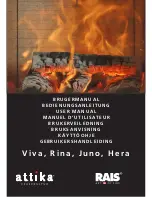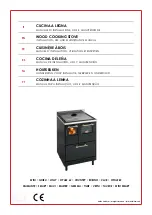
Magnafire Series Coal Stoves
9
3-90-70746R13_03/14
Operation
5. Operating Instructions
5.1 STARTING A FIRE
Place seven or eight sheets of crumpled newspaper onto
the top of the grates. Next, lay in some small kindling wood
(approximately 3/4” or less) on top of the newspaper. Layer
the kindling in a criss-cross fashion to allow for maximum
air flow. Open the draft control to it’s full open position. Light
the paper nearest the center of the door opening and close
and latch the load door. After two to three minutes, open
the load door an inch or two for a few seconds, then open
it completely. This method is good practice to allow smoke
to clear away from the load door. Add a few small pieces of
firewood when the kindling is burning well. Close the door
again and be sure the draft control remains open. The ash
door itself may be opened for a short period to accelerate
the process.
DO NOT LEAVE THE STOVE UNATTENDED WITH THE
DOOR OPEN.
When a substantial bed of hot wood coals are built up, start
adding small amounts of coal on top of the burning wood
embers. (Pea or Nut sized coal will give the best results
when starting a fire.) Keep the draft control open through
the whole ignition process. As the coal begins to free-burn,
continue adding small amounts until there is a solid bed of
burning coal. Do not add too much at one time as you could
smother the fire. Allow sufficient time between these small
batches so that the coal can ignite thoroughly before more is
added. Once a substantial bed is established, fill the firebox
to the top of the bricks. A deep bed of coal will always burn
better than a shallow bed. Adjust the draft control to the
desired heat output. You’ll learn over time that the coal fire
does not instantly change with a turn of the draft control.
Make your adjustments in small increments and wait for the
fire to stabilize. The normal range of control settings will be
from closed, for extended burn times, to one full turn open.
NOTE:
If the ash door was opened during the lighting
process, it must be closed to prevent over-firing. Over-firing
can cause dangerously high temperatures.
5.2 LOADING
Coal should never be added unless there is a reasonably
hot fire. The coal bed should be bright and vigorous. If the
fire is burning hot and there is a deep bed of hot coals, full
loads of coal can be added at any time. However, if there is
not a deep bed of coals, it is best to add in small batches as
during lighting.
5.3 INCREASING HEAT FROM A LOW FIRE
Every effort should be made to not let a coal fire burn so long
that it begins to die. This causes the reloading process to be
much longer, and there is a good possibility of losing the fire
all together. Do not shake or stir a low fire. Open the draft
control or the ash door to get the maximum air flow. Allow
the fire to get reasonably hot. If there is not enough un-
burned coal to renew the fire, add a small amount. Continue
adding coal in small amounts until a full bed is established.
Now, shake the grates. (see next section “shaking ashes”)
5.4 SHAKING ASHES
Shaking should be done only when there is a hot fire. The
frequency of shaking will depend on the rate of burning.
Shaking should be done at least once per day but best
results will come from shaking twice a day.
When shaking, do just that. Do not rock the handle in long
strokes, just shake it briskly until you see red hot ashes fall
into the ash pan. Rocking the grates may allow pieces of
coal to jam them in an open position.
DO NOT LEAVE THE STOVE UNATTENDED WITH THE
DOOR OPEN.
5.5 ASHES AND THEIR REMOVAL
Ashes should never be allowed to accumulate in the ash
pan. Excess ash build up can restrict air flow to the fire and
can also cause damage to the grates.
Ashes should be placed in a metal container with a tight
fitting lid, pending final disposal. The closed container of
ashes should be placed on a non-combustible floor or on
the ground, well away from any combustible materials. If the
ashes are disposed of by burial in soil or otherwise locally
dispersed, they should be retained in the sealed container
until all cinders have thoroughly cooled.
Coal produces considerably more ash than wood. For equal
heat output, coal will produce 7 to 10 times the ash of a
wood fire.
CAUTION
!
ASHES SHOULD NEVER BE ALLOWED TO
ACCUMULATE ABOVE THE TOP OF THE ASH PAN.
ASHES IN CONTACT WITH THE BOTTOM OF THE
GRATES ACT AS AN INSULATOR INTENSIFYING
THE HEAT ON THE GRATES, AND WILL CAUSE
THE GRATES TO WARP. GRATE DAMAGE FROM
ASH BUILD UP IS EASILY RECOGNIZED. PLEASE
REFER TO YOUR WARRANTY TO SEE
LEGACY
STOVES
TM
LIMIT OF LIABILITY IN CASES OF ABUSE
OR NEGLECT.
Summary of Contents for Magnafire Mark I
Page 2: ...3 90 70746R13_03 14 ...
Page 19: ...3 90 70746R13_03 14 ...






































